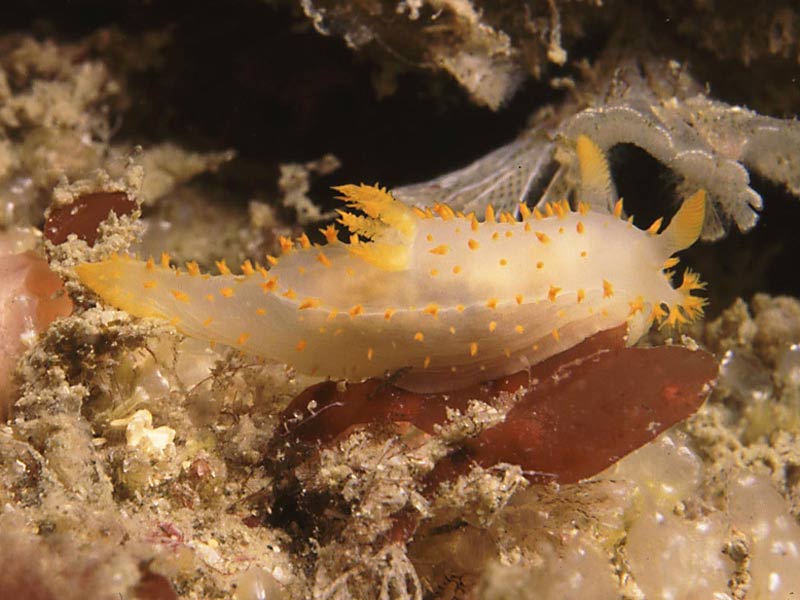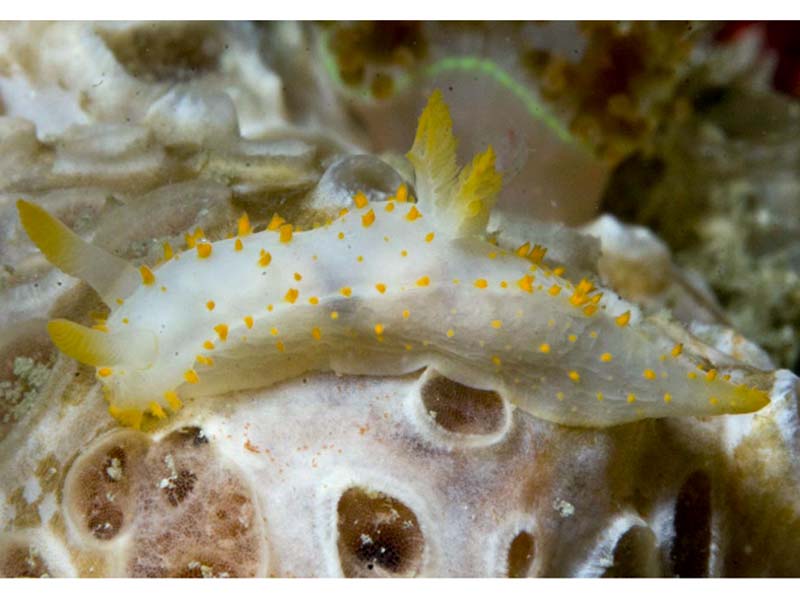A sea slug (Crimora papillata)
Distribution data supplied by the Ocean Biodiversity Information System (OBIS). To interrogate UK data visit the NBN Atlas.Map Help
| Researched by | Sonia Rowley | Refereed by | Admin |
| Authority | Alder & Hancock, 1862 | ||
| Other common names | - | Synonyms | - |
Summary
Description
Recorded distribution in Britain and Ireland
This uncommon nudibranch has recently been recorded in large numbers in the south and west coasts of the British Isles. It has also been recorded as far north as St. Kilda.Global distribution
-Habitat
Crimora papillata is a sublittoral species probably found at depths over 30 meters on the bryozoans Chartella papyracea, Flustra foliacea and Securiflustra securifrons.Depth range
-Identifying features
- Translucent white to yellow body up to 3.5 cm in length.
- Covered in distinctive yellow-orange tubercles.
- The tips of the tubercles are branched or arborescent.
- The lamellate rhinophores, oral tentacles and gills are tipped with yellow-orange pigmentation.
Additional information
Crimora papillata feeds on bryozoans, primarily Chartella papyracea, but also Flustra foliacea or Securiflustra securifrons. Until 1972, this species was regarded as one of the rarest nudibranchs in the British Isles (Thompson, 1988).The spawn of this species is bright yellow (Rudman, 2002c) and its penis bears numerous hooked spines (Thompson, 1988).
Listed by
- none -
Bibliography
Costello, M.J., Bouchet, P., Boxshall, G., Emblow, C. & Vanden Berghe, E., 2004. European Register of Marine Species [On-line]. http://www.marbef.org/data/erms.php,
Howson, C.M. & Picton, B.E., 1997. The species directory of the marine fauna and flora of the British Isles and surrounding seas. Belfast: Ulster Museum. [Ulster Museum publication, no. 276.]
Picton, B. E. & Morrow, C.C., 1994. A Field Guide to the Nudibranchs of the British Isles. London: Immel Publishing Ltd.
Rudman, W.B., 2002. Crimora papillata [on-line]. http://www.seaslugforum.net/, 2002-09-15
Seaward, D.R., 1990. Distribution of marine molluscs of north west Europe. Peterborough: Nature Conservancy Council.
Thompson, T.E., 1988. Molluscs: Benthic Opisthobranchs. London: Bath Press. [Synopses of the British Fauna New Series), (ed. Doris M. Kermack & R.S.K. Barnes), no. 8 (second Edition)].
Datasets
Conchological Society of Great Britain & Ireland, 2018. Mollusc (marine) data for Great Britain and Ireland - restricted access. Occurrence dataset: https://doi.org/10.15468/4bsawx accessed via GBIF.org on 2018-09-25.
Conchological Society of Great Britain & Ireland, 2023. Mollusc (marine) records for Great Britain and Ireland. Occurrence dataset: https://doi.org/10.15468/aurwcz accessed via GBIF.org on 2024-09-27.
NBN (National Biodiversity Network) Atlas. Available from: https://www.nbnatlas.org.
OBIS (Ocean Biodiversity Information System), 2025. Global map of species distribution using gridded data. Available from: Ocean Biogeographic Information System. www.iobis.org. Accessed: 2025-08-08
South East Wales Biodiversity Records Centre, 2018. SEWBReC Molluscs (South East Wales). Occurrence dataset: https://doi.org/10.15468/jos5ga accessed via GBIF.org on 2018-10-02.
Citation
This review can be cited as:
Last Updated: 26/02/2007




